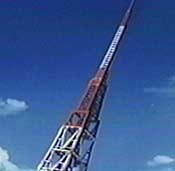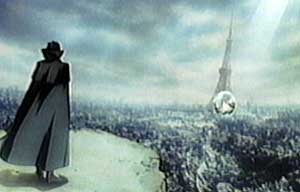by Luis Reyes
Emblematic of Tokyo city, its gnarled frame is also a premonition of Tokyo's destruction, which in anime symbolizes global destruction (anime artists employ the same kind of
solipsism that American disaster movie directors use when they set their horsemen loose in New York).
Like the once colossal statue in Shelley's Ozymandias, the Tokyo Tower embodies all that is great and powerful
about its home. And its oft-eulogized, ubiquitous presence in the backdrop of post-apocalyptic anime cityscapes has
rendered the lattice-framed edifice a moss-covered gravestone for civilization itself. However, the mythos of the
tower itself overshadows its function.
Standing slightly higher than its structural kin, the Eiffel Tower, Tokyo Tower rises 333 meters into the Tokyo
sky. A relay tower for nine television stations and five radio stations, the red and white landmark also houses an
earthquake detection system, traffic tracking equipment, two observations decks, teahouses, shops and an aquarium
among other attractions. A member of the World Federation of Great Towers - an Australia-based organization committed
to promoting awareness of man's architectural marvels - Tokyo Tower is the tallest, stand-alone steel structure in the
world. And at night 164 lights, which cast a reassuringly warm glow across the entire city, illuminate its
international glory. Constructed in 1958, its erection marked a new beginning for a Tokyo that for 13 years had been
engaged in rebuilding a nation from the cataclysmic ruin of World War II - an iconic phoenix from the ashes that
re-invigorated a proud culture while also marking that culture's prominence among modern metropolises.
But with modernity comes an increasingly more vicious clash with nature, and Tokyo's tumbles with earthquakes,
inclemency and pollution have struck at the already weakened bedrock of Japanese confidence. But Tokyo Tower has
survived, too well built for the specters of earthquakes, too strong for the wrath of the weather and higher than
pollution will climb.
However, the residue of vulnerability clings to the Japanese public consciousness, thus even the seemingly
stalwart manifestation of Tokyo succumbs to larger, darker and often unpredictable forces.
The "Agent Aika" OAV series opens with a glass-bottom boat tour of Tokyo harbor on which a bubbly guide concludes
a site seeing tour of submerged city streets with a sensational narration of how the mighty Tokyo Tower once loomed
over the skyline but now only peeps out of the water at an incline of 23.7 degrees. Her effervescence belies the
tragedy that has befallen the city. In Clamp's "X" a vision of the future prophesies a devastated Tokyo in rubble at
the feet of a precariously balanced Tokyo Tower (the contrasting present day scenario depicts the tower as a luminous
beacon of hope). The tower's pieces lay in ruin in "Akira."
Analogous to the Statue of Liberty in "Logan's Run" and "Planet of the Apes," Tokyo Tower in anime represents
the quintessence of Japanese strength, technology and renown that, when consumed by other forces, exposes the city's,
and inherently the world's, vulnerability. But as those that remember the Armageddon of the recent past acquiesce to
those who only understand Armageddon as a movie with Bruce Willis, will Tokyo Tower lose the context for its elegiac
depiction in anime? Perhaps, but as special effects and computer animation improve, you can bet that the fascination
with our own destruction will only grow.
http://info.nttls.co.jp/webcam/ features a live picture taken of Tokyo Tower every couple of minutes. If
Tokyo does meet its end in a demonic conflagration, this is the place for box seats.
Other related websites:
|
||||||
|
Agent Aika © Studio Fantasia / Bandai Visual / Central Park Media
X © Manga Ent.
|


